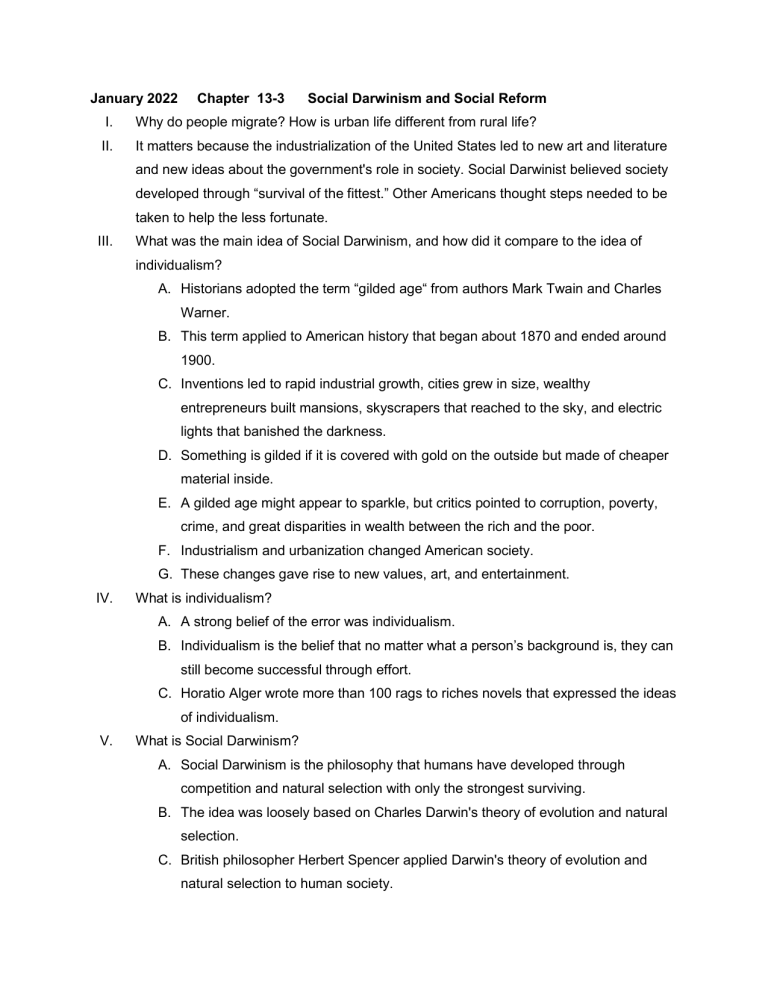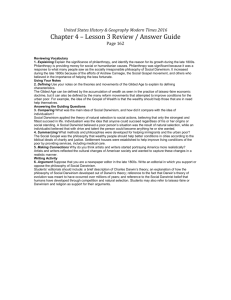
January 2022 Chapter 13-3 Social Darwinism and Social Reform I. Why do people migrate? How is urban life different from rural life? II. It matters because the industrialization of the United States led to new art and literature and new ideas about the government's role in society. Social Darwinist believed society developed through “survival of the fittest.” Other Americans thought steps needed to be taken to help the less fortunate. III. What was the main idea of Social Darwinism, and how did it compare to the idea of individualism? A. Historians adopted the term “gilded age“ from authors Mark Twain and Charles Warner. B. This term applied to American history that began about 1870 and ended around 1900. C. Inventions led to rapid industrial growth, cities grew in size, wealthy entrepreneurs built mansions, skyscrapers that reached to the sky, and electric lights that banished the darkness. D. Something is gilded if it is covered with gold on the outside but made of cheaper material inside. E. A gilded age might appear to sparkle, but critics pointed to corruption, poverty, crime, and great disparities in wealth between the rich and the poor. F. Industrialism and urbanization changed American society. G. These changes gave rise to new values, art, and entertainment. IV. What is individualism? A. A strong belief of the error was individualism. B. Individualism is the belief that no matter what a person’s background is, they can still become successful through effort. C. Horatio Alger wrote more than 100 rags to riches novels that expressed the ideas of individualism. V. What is Social Darwinism? A. Social Darwinism is the philosophy that humans have developed through competition and natural selection with only the strongest surviving. B. The idea was loosely based on Charles Darwin's theory of evolution and natural selection. C. British philosopher Herbert Spencer applied Darwin's theory of evolution and natural selection to human society. D. Natural selection is the idea that species that cannot adapt to the environment in which they live gradually die out, while those that do adapt, thrive, and live on. E. Society, in Spencer’s eyes, became better because only the fittest people survived. F. William Graham Sumner was another social Darwinist. G. Some industrial leaders use social Darwinism to justify their support of laissezfaire capitalism. H. This economic doctrine opposed any government programs that interfered with business. I. Devout Christians found Darwin's conclusions offensive. J. They rejected the theory of evolution because they believe it contradicted the Bible's account of creation. K. Some clergy, however, such as Henry Ward Beecher, call themselves “Christian evolutionists”. L. Andrew Carnegie advocated a gentler version of social Darwinism that he called the Gospel of Wealth. M. This philosophy held that wealthy Americans should engage in philanthropy, using their fortunes to create the conditions that would help people help themselves. N. Carnegie did not advocate for handouts, but believed that building schools, hospitals, and libraries would help the poor. O. Carnegie’s ideas were embraced by the nation's wealthy. P. John D Rockefeller founded the University of Chicago, and many universities, including Stanford, Vanderbilt, and Johns Hopkins are named for the wealthy businessman who helped found them. Q. All across the nation, museums of art, symphonies, and operas were funded by wealthy patrons. VI. What methods and philosophies were developed for helping the urban poor? A. Some disagreed with the ideas of individualism and Social Darwinism. B. These people said that society's problems could be fixed only if Americans and their government began to take a more active role in regulating the economy and helping those in need. VII. What challenged Social Darwinism? A. In 1880, journalist Henry George published Progress and Poverty, a discussion of the American economy that quickly became a national best seller. B. He claimed that the “gulf between the employer and the employee is growing wider” and that “social contrasts are becoming sharper”. C. Industrialism did make some Americans very wealthy, but it also improved the standard of living for most others as well. D. At the time, however, Americans in the midst of poverty did not see improvement. E. In 1883, Lester Frank Ward published dynamic sociology, in which he argued that humans were different from animals because they have the ability to make plans to produce the future outcomes they desired. F. Ward’s ideas came to be known as Reform Darwinism. G. People, he insisted, had succeeded in the world because of their ability to cooperate. H. He argued the government could regulate the economy, cure poverty, and promote education more efficiently than competition in the marketplace could. I. Edward Bellamy published looking backward, a novel about a man who falls asleep in 1887 and awakens in the year 2000 to find that the nation has become a perfect society with no crime, poverty, or politics. J. Bellamy’s ideas were essentially a form of Socialism. K. Naturalists challenge the idea of social Darwinism by suggesting that some people failed in life simply because they were caught up in circumstances they could not control. L. Stephen Crane, Jack London, and Theodore Dreiser were all prominent naturalist writers. M. Naturalist literature drew people's attention to the issues and problems facing American society as a result of rapid industrialization and urbanization. N. The literature had a positive impact and encouraged readers to look at social problems. O. By downplaying heroism and the ability of people to make a difference in their life, it discouraged people from taking action, and encouraged envy and resentment towards people of different social classes. P. Naturalism also implicitly asked readers to consider whether individualism and laissez-faire was leading to the best possible society. VIII. How did people help the urban poor? A. The Social Gospel movement worked for better conditions in cities according to the biblical ideals of charity and justice. B. Washington Gladden was a minister and advocate who popularized the movement in writings. C. The Social Gospel movement inspired many churches to build gyms, provide social programs in childcare, and help the poor. D. The Salvation Army and the Young Men’s Christian Association also combined faith and an interest in reform. E. The Salvation Army offered practical aid and religious counseling to the urban poor. F. The YMCA tried to help industrial workers in the urban poor by organizing Bible studies, citizenship training, and group activities. G. The YMCA also provided low-cost boarding houses for young men. H. Dwight L Moody was the head of the Chicago YMCA and rejected both the Social Gospel movement and Social Darwinism. I. He believed the way to help the poor was not by providing them with services but by redeeming their souls and reforming their character. J. Settlement houses are institutions located in poor neighborhoods that provide numerous community services such as medical care, childcare, libraries, and English classes. K. In the late 1800s, idealistic reformers established these houses. L. The reformers lived in the settlement houses. M. Jane Addams opened Hull House in Chicago in 1889. N. Jewish reformer Lillian Wald founded the Henry Street Settlement in New York City. IX. What was public education like? A. As the United States became increasingly industrialized and urbanized, they needed more trained and educated workers. B. The number of children attending school rose from 7,500,000 in 1872 to 15,500,000 in 1900. C. At school, migrant children were taught English and learned about American history and culture, a process known as Americanization. D. Grammar schools divided students into grades and drooled them in punctuality, nurse, and efficiency – necessary habits for the workplace. E. Vocational education and high schools taught skills required in specific trades. X. Why do you think artists and writers started portraying America more realistically? A. The late 1800s was a period of great cultural change for writers and artists. B. Many urban Americans began taking advantage of new forms of entertainment. XI. What was realism in art and literature? A. Realism began in the 1800s. B. Artists and writers tried to portray the world realistically. C. Realist artists did not generally choose heroic or historical topics. D. Instead they painted ordinary people doing ordinary things. E. Among the best known of the realist painters are John Singer Sargent and Thomas Eakins. F. The realist style captured many of the characteristics of the era such as clothing styles, social relationships, the differences between social classes, and the way people look doing ordinary things in life. G. Writers such as William Dean Howells also tried to capture the world as they saw it. XII. What was significant about popular culture during this time period? A. Industrialization improved the standard of living for many people, enabling them to spend money on entertainment and recreation. B. Urban Americans divided their lives into separate units – that of work and not at home. C. In cities, saloons often outnumbered groceries. D. As a place for social gathering, saloons played a major role in the lives of male workers and even politicians. E. Working class families and single adults could find entertainment at new amusement parks such as New York City‘s Coney Island. F. People also began watching professional sports. G. As work became less strenuous, many people look for activities involving physical activity. H. Tennis, golf, and croquet became popular. XIII. What is Tin Pan Alley? A. Adapted from French theater, vaudeville took on an American flavor in the early 1880s with its hodgepodge of animal acts, singers, comedians, acrobats, and dancers. B. Ragtime music also became popular. C. From the early 1880s to the late 1930s, the music industry in America was centered in New York City. D. The part of the city where many music publishers and songwriters were located became known as Tin Pan Alley. E. Tin Pan Alley musicians in publishers made most of their money by selling sheet music. F. Very few people owned phonographs in the 1880s and 1890s, but many homes had pianos, banjos, and other instruments, and people would play popular songs for themselves and their families. G. The negative impact of Tin Pan Alley, especially in its early years, was that it continued to promote racial stereotypes. H. The style and sound of the Alley was derived from African-American songs and music but with themes and content that appeal to white Americans. I. Racial jokes and ideas probably played a role in sustaining the racism of the era and the social separation of whites and African-Americans. XIV. Conclusion: How is urban life different from rural life? A. Urban life was characterized by more progressive thinking and more progressive art forms. Quality of life was improved for many people and access to education and healthcare became more widespread. Unfortunately, however, problems such as poverty, crime, and discrimination still existed in the urban setting. Despite these problems, philanthropy began and industry expanded.






